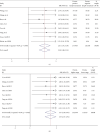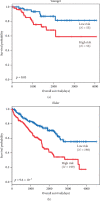Effect of COL4A1 Expression on the Survival of Neoadjuvant Chemotherapy Breast Cancer Patients
- PMID: 32565804
- PMCID: PMC7255048
- DOI: 10.1155/2020/5209695
Effect of COL4A1 Expression on the Survival of Neoadjuvant Chemotherapy Breast Cancer Patients
Abstract
Optimal therapy for each patient depends on their subtype, anatomic cancer stage, gene status, and preferences. Neoadjuvant chemotherapy-treated tumors have shown attenuated tumor growth, but the therapy cannot completely reduce tumor cell dissemination to blood stream and distant metastasis. Though it has been indicated that the protein of the collagen type IV alpha 1 (COL4A1) gene is induced by p53 to inhibit angiogenesis and tumorigenic activity in cancer cells, its prognostic significance in breast cancer (BC) patients has not yet been fully elucidated. We analysed 206 BC and fresh paired-match adjacent normal breast tissue from tissue microarrays (TMAs) and COL4A1-stained TMAs using immunohistochemistry. These were used to evaluate COL4A1 expression in BC and to analyse the relationship between this expression and clinicopathological factors and prognosis. The expression of the COL4A1 protein was significantly higher in normal adjacent tissue than in the tumor tissues of BC (P < 0.0001). The low COL4A1 expression of the BC patients had decreased metastasis incidence ratio than those exhibiting high COL4A1 expression (P=0.034). Low COL4A1 expression in the tumor cells of BC patients was found to significantly reduce the overall survival (OS) and relapse-free survival (RFS) rates of neoadjuvant chemotherapy patients (P=0.047 and P=0.025, respectively). We also validated the results to ensure their consistency with a web server program for survival analysis from the Cancer Genome Atlas (TCGA) database (P=0.057). Additionally, COL4A1 expression was positively correlated with p53 expression (P=0.00076). Thus, we present clinical evidence that COL4A1 expression can be used as a biomarker of better prognosis of BC patients receiving neoadjuvant chemotherapy.
Copyright © 2020 Shin-Mae Wang et al.
Conflict of interest statement
The authors confirm that there are no conflicts of interest associated with this publication.
Figures





Similar articles
-
COL4A1 as a novel oncogene associated with the clinical characteristics of malignancy predicts poor prognosis in glioma.Exp Ther Med. 2021 Nov;22(5):1224. doi: 10.3892/etm.2021.10658. Epub 2021 Aug 27. Exp Ther Med. 2021. PMID: 34539820 Free PMC article.
-
Complete Metabolic Response on Interim 18F-Fluorodeoxyglucose Positron Emission Tomography/Computed Tomography to Predict Long-Term Survival in Patients with Breast Cancer Undergoing Neoadjuvant Chemotherapy.Oncologist. 2017 May;22(5):526-534. doi: 10.1634/theoncologist.2016-0334. Epub 2017 Apr 4. Oncologist. 2017. PMID: 28377466 Free PMC article.
-
Obesity is an independent prognostic factor of decreased pathological complete response to neoadjuvant chemotherapy in breast cancer patients.Breast. 2017 Apr;32:237-244. doi: 10.1016/j.breast.2016.05.013. Epub 2016 Jun 16. Breast. 2017. PMID: 27318645
-
Overview of resistance to systemic therapy in patients with breast cancer.Adv Exp Med Biol. 2007;608:1-22. doi: 10.1007/978-0-387-74039-3_1. Adv Exp Med Biol. 2007. PMID: 17993229 Review.
-
Breast cancer under age 40: a different approach.Curr Treat Options Oncol. 2015 Apr;16(4):16. doi: 10.1007/s11864-015-0334-8. Curr Treat Options Oncol. 2015. PMID: 25796377 Review.
Cited by
-
Unveiling Collagen's Role in Breast Cancer: Insights into Expression Patterns, Functions and Clinical Implications.Int J Gen Med. 2024 May 2;17:1773-1787. doi: 10.2147/IJGM.S463649. eCollection 2024. Int J Gen Med. 2024. PMID: 38711825 Free PMC article. Review.
-
COL4A1 as a novel oncogene associated with the clinical characteristics of malignancy predicts poor prognosis in glioma.Exp Ther Med. 2021 Nov;22(5):1224. doi: 10.3892/etm.2021.10658. Epub 2021 Aug 27. Exp Ther Med. 2021. PMID: 34539820 Free PMC article.
-
Effects of a humanized CD47 antibody and recombinant SIRPα proteins on triple negative breast carcinoma stem cells.Front Cell Dev Biol. 2024 Mar 1;12:1356421. doi: 10.3389/fcell.2024.1356421. eCollection 2024. Front Cell Dev Biol. 2024. PMID: 38495618 Free PMC article.
-
COL4A1 promotes the proliferation and migration of oral squamous cell carcinoma cells by binding to NID1.Exp Ther Med. 2023 Mar 7;25(4):176. doi: 10.3892/etm.2023.11875. eCollection 2023 Apr. Exp Ther Med. 2023. PMID: 37006878 Free PMC article.
-
Establishment and Analysis of an Individualized EMT-Related Gene Signature for the Prognosis of Breast Cancer in Female Patients.Dis Markers. 2022 Jul 28;2022:1289445. doi: 10.1155/2022/1289445. eCollection 2022. Dis Markers. 2022. PMID: 35937944 Free PMC article.
References
LinkOut - more resources
Full Text Sources
Research Materials
Miscellaneous

